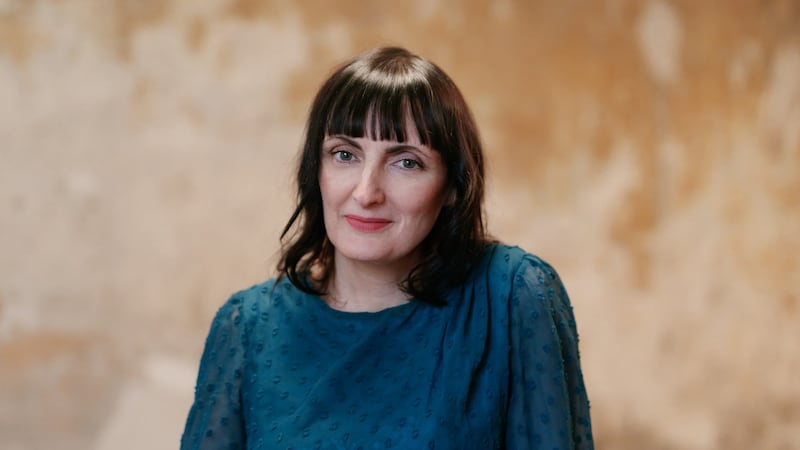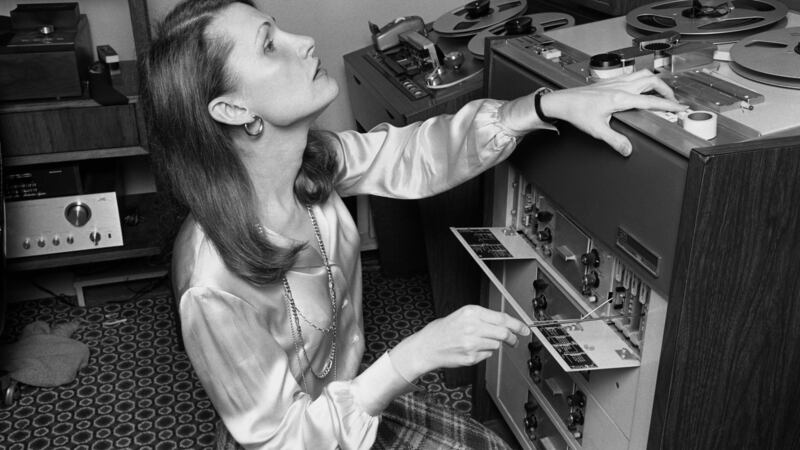In the summer of 2019, Kim Gordon – musician, visual artist, writer, and former member of the legendary rock band Sonic Youth – arrived in Dublin. She did a live interview at the Light House cinema with writer Sinéad Gleeson. “I interviewed Kim about her art, as her solo show had just opened at IMMA,” says Gleeson. “Her band Body/Head played a great show in the IMMA courtyard too, and [afterwards] Kim, her daughter Coco, [singer] Heather Leigh – who was also on the bill – and the brilliant US poet Elaine Kahn all hung out in the Royal Oak [pub].”
Shortly afterwards, Gordon was in London where she met editor Lee Brackstone, who had moved from Faber to start a new music book imprint, White Rabbit. Brackstone asked Gordon about the possibility of working on an anthology of essays by women about music. Gordon had plenty of experience as a writer – her memoir, Girl in a Band, was published in 2015 – but not as an editor. She thought Gleeson, author of the acclaimed essay collection Constellations and the editor of several award-winning anthologies, would be a perfect collaborator. “I had just met Sinead right before I saw Lee in London, so it just seemed natural,” says Gordon. “Because, you know, she’s great.”
The project instantly appealed to Gleeson. “So [much of] the mythologising of the music story has been about men,” she says. “So, well, why not do a book that’s not about men?”
The result of this fortuitous sequence of events, This Woman’s Work, is a dazzling, unpredictable collection of essays (with an introduction by Heather Leigh). The book brings together novelists, essayists, music and literary critics and poets from all over the world, from Anne Enright, Fatima Bhutto and Ottessa Moshfegh to Yiyun Li, Maggie Nelson and Margot Jefferson, writing about everything from folk to trap, from American jazz to Pakistani songs of resistance.

When planning the book, both Gordon and Gleeson approached potential contributors, who were given free rein when it came to the topics and forms of their essays. “There was no brief,” says Gleeson. “And sometimes that can be kind of scary because you don’t know what you’re going to get back, or if it’s going to be what you’re looking for. And in this case, thankfully, it was. The only conversation we had was around diversity and inclusion. We didn’t want this to be a book of a lot of people who are from the same backgrounds as myself or Kim. That was important.”
Both Gordon and Gleeson feel that giving contributors such freedom led to more powerful pieces. “I think if you tell people they can write about what they want, they tend to write about things that are really important, things they’re passionate about,” says Gleeson. “And I think that comes through in the strength of the writing. It doesn’t matter what you’re writing about, if you know your subject and you feel very strongly about it, the chances are it’s going to be a very impactful piece of writing, if all that [feeling] is in it. And I think it is, in all of these pieces.”
Gordon agrees. “I don’t know all the writers, not that many of them actually,” she says. “But the ones I do know, their personality really comes through in the writing and what they chose. The Juliana Huxtable piece [on the groundbreaking experimental jazz singer Linda Sharrock], it’s so her, you know. It’s poetic and also abstract.”
Gordon believes that a plurality of voices can challenge preconceived ideas about both female musicians and writers. “A lot of female musicians get asked the question, ‘What’s it like to be a girl in a band?’ And it’s all assuming that we’re all [basically] the same person. But the more women play music, the more you see different personalities. So it’s not just about being stereotyped in one way or another. And I think that these essays kind of do the same thing.”
While some of the contributors have written extensively about music before, or are involved in the music industry and music journalism, both Gleeson and Gordon feel that the fact that many of the contributors were known for other forms of writing was a bonus.
“I think there’s something really interesting about asking people who mainly write fiction, who create other worlds and fake people and fake universes, to write something that’s not made up,” says Gleeson. “Novelists get to hide in fiction ... but you can’t hide in nonfiction. So I was really excited to see what the fiction writers would do, because there’s no pillars they can dodge behind.” Gordon suspects it could have been liberating. “When you write in a genre you’re not used to writing in, maybe it’s easy, because there aren’t the same expectations,” she says.
Both were struck by the variety of contributions. Even though none of the contributors knew what the others were writing about, there were, Gleeson says, “little echoes across the book, like Lucinda Williams appears in a couple of essays and Kraftwerk are mentioned a couple times”. The variety continues in the forms of the essays themselves. One of the book’s most striking pieces is academic and poet Simone White’s What Is Going On in Rap Music, the Music Called ‘Trap’ and ‘Drill’?. “It’s an incredibly hybrid and brilliant essay,” says Gleeson. “I think a lot of people won’t have seen that kind of writing in a piece like that, because… it’s very formally different. And she just knows her subject back to front…It won’t be for everybody, but that piece is going to blow some people’s minds. I haven’t seen that kind of hybridity in music writing, personally.”

Both editors contributed pieces. Gordon chose to conduct an in-depth interview with the Japanese musician Yoshimi Yokota, drummer with The Boredoms and Gordon’s former bandmate in Free Kitten. The result is a fascinating and revelatory portrait that helped Gordon gain a new insight into the life of a collaborator and friend. In the interview, which was conducted via a translator, Yoshimi was able to express herself to Gordon in a way that she hadn’t before.
“It was an opportunity, because she could really explain things,” says Gordon. “Even though I’ve known her for years, her English isn’t that good; she can understand a lot more than she can speak. She’s such an unconventional musician and person within a culture where conformity is really prized, and I was always curious about her initial background and upbringing. And I felt like it would maybe infuse the book with a different kind of energy too.”
Gleeson wrote a powerful essay about Wendy Carlos, the brilliant musical innovator best known for her bestselling Switched-On Bach album and her soundtracks for The Shining and A Clockwork Orange. She chose to write about Carlos because “there’s not very much written about her. And because she’s become so reclusive, there aren’t any recent interviews or interviews. I started to feel very sad about the idea of her legacy slipping away and the fact that loads of people, especially the generations coming after me, won’t know about her. [They] won’t know what an absolutely monumental influence she is on the history of synthesized music, modular synths, film composition, all of these things.”
Both Gleeson and Gordon hope the book will inspire readers to check out the featured musicians, some of whom were unfamiliar to both editors beforehand. “I think if it had been a book about 20 people we all know very well, maybe it wouldn’t be as interesting a book,” says Gleeson. “I hope that lots of people will find out about songs or movements, or genres, or specific singers from this book, and immediately go off and discover something that they might not like, or that might be something they’ve been waiting to hear their whole life.” She’s in the process of creating a Spotify playlist to accompany the book, making it easier for readers to check out the featured artists.
The co-editors hope the ripples of the book will continue to reverberate. “I hope that it inspires women to write their own essays about their memory and experience with music, because everyone has that [experience],” says Gordon. “It’s a nice way to get someone interested in writing.”
A British journalist recently told Gleeson she believed that the book had the potential to expand into a series. Gleeson is tempted by the idea. “There are so many more stories that we don’t know, or that need to be told or deserve to be told,” she says. “So maybe come back to me and Kim when we’ve had a good rest.”
This Woman’s Work is published by White Rabbit.












